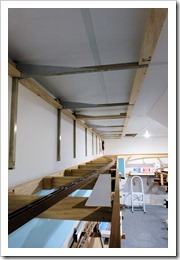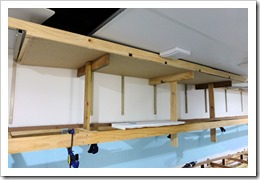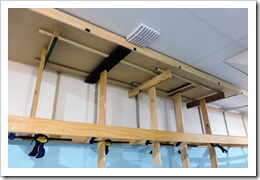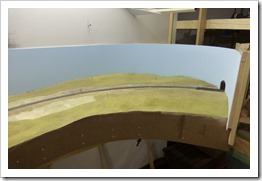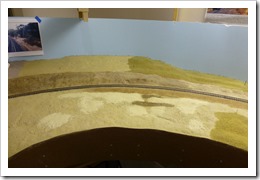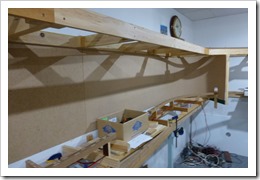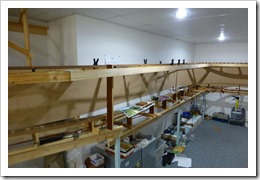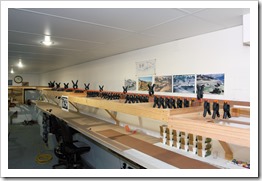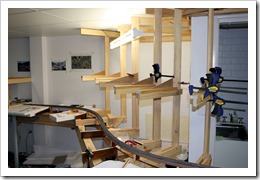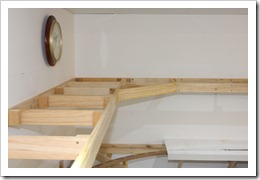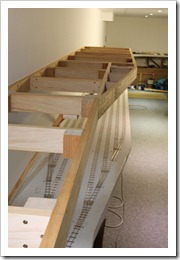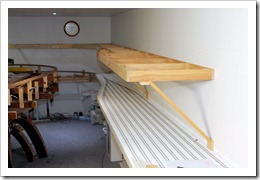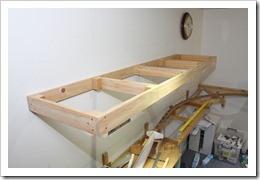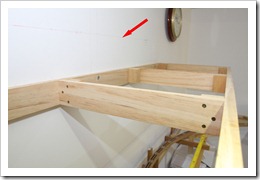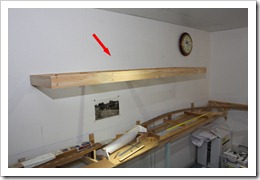Blog Archives
Upper deck progress …
Hi all,
Since my last post, I have been busy with work on the upper deck above the Chilcott’s Ck to Kankool section.
To support the upper deck valance and future lighting, steel brackets were fabricated from second hand 20x20mm square tube, along with bracing made from thin steel plate.
A simple timber jig was made to hold the pieces of tube in place whilst the brace plate was attached using pop rivets.
These brackets were then screwed to the wall at strategic locations at wall studs.
After the initial installation of these brackets, I discovered a potential flaw in my design. The two rivets fixing the brace plate to the vertical tube were shearing off with only minimal downward force being exerted at the outer end of the horizontal tube. Now, I’m not sure whether it was actual rivet failure or what, so I decided to replace these rivets with a 3/16” bolt/spring washer/nut combination. The result is a much stronger feeling bracket.
I had also decided to install a ceiling above each scene, as I didn’t fancy the idea of being able to see the open benchwork when looking along the scene from one end. Once painted, I also think it will assist in spreading the light onto the scene.
The ceiling is made from sheets of 3.2mm MDF (2440x1220mm). This required the installation of a timber sub-frame built around the steel brackets to allow for the securing of the ceiling. 2×1 DAR pine was used.
More framing was also installed in the corner to support the backscene and ceiling.
A ceiling section was cut to size from the MDF and secured to the timber frame using Liquid Nails and small gauge countersunk screws. The adhesive was also applied to the steel tube. Temporary supports were used to hold the ceiling in place whilst fixing the screws. After the screws were installed, extra temporary supports were fitted to force the ceiling against the steel tube whilst the adhesive cured.
The ceiling section in the corner proved to be quite tricky to cut to size, but by using accurate measurements, I ended up with a piece that fitted perfectly.
A couple more sections of backscene was also installed, including the piece in the corner.
These sections of backscene have no need to extend completely down to the benchwork, as the track level will be around where the lower edge of the MDF is in the picture above, and the majority of scenery here behind the track will be hills covered with trees.
I also started playing around with how I will locate the Kankool lever frame into the fascia. The picture below shows a mock-up of what I hope to achieve.
The MDF immediately behind the frame will be the scene fascia and the curved piece in front is to indicate another section of fascia that will serve as ‘protection’ for the frame. More on this later.
Cheers.
Layout progress update …
Hi all,
Apologies for the lack of updates since early Dec last year. I have been busy with some scenery in the Temple Court section as well as some more benchwork and spline construction.
Temple Court scenery
I’ve made a start on some static grass application but have not done much since Christmas. It’s been tricky getting the look and colours right, but I think it will look OK as it progresses.
Some pics below of the progress so far.
I still haven’t done any more with the rocky outcrop, but you can see lots of plaster castings sitting around for inspiration.
Lower level backscene, upper deck benchwork and spline
I also started installing the backscene from staging through Kankool, including the entry from staging onto the Chilcott’s Ck bridge scene.
The last picture above shows the new supports installed for the upper deck above Kankool as well for backscene support. As mentioned previously, I am using 3mm MDF as the backscene and this will be painted with the sky colour.
I had always planned to work on the lower deck scenery and trackwork from Chilcott’s Ck bridge to Ardglen first before the upper deck, mainly due to thinking I would have access issues on the lower deck for scenery work if I built the upper deck benchwork. In the last few weeks I have since decided to progress with upper deck benchwork, spline and scenery from Ardglen through to Pangela as the next stage.
This all came about after I had started to think about getting the bridge in place and laying track from staging through Kankool. But I realised that this may not be such a good idea as once the bridge was installed, and I had scenery in place, I would be working above all this with the ever present danger of things falling on the scene below.
So, the decision was made to continue with upper deck benchwork above Kankool and around to Pangela as well with spline construction from Ardglen to Pangela.
As I had already built the benchwork for Ardglen and the section above Chilcott’s Ck to Kankool some time ago (see previous post), I started to lay out the spline in this area.
As mentioned above, the plan is to continue with upper deck benchwork all the way from Kankool through Pangela and to build the spline from Ardglen to Pangela, then start on basic scenery formation. Once all the messy stuff with plaster is done on the upper deck, I’ll probably then look at getting the Chilcott’s Ck bridge installed and continuing with scenery through Kankool and beyond towards Ardglen.
Cheers for now.
Work continues on Temple Court section …
Hi all,
Since my last post on Temple Court, I have been busy continuing with benchwork for the backdrop in this section as well as installing some upper deck supports.
I also added extra bracing back to the walls to strengthen the whole thing.
I have had to do quite a lot of thinking about the deck separation and depth of scenes around Temple Court, as, for me to continue with spline construction up into Ardglen, I needed to have some supports in place. This meant working out a bracket design that would support the spline and scenery, as well as maximising deck separation below to Temple Court.
I always had the idea of making the upper deck brackets out of 20mm square steel tube, mainly to maximise deck separation, but also because I had heaps of the stuff left over from an old balustrade system from around our outdoor deck.
As it turns out, at least in this section, I decided to use only a few steel brackets, as I could see issues with fixing future timber risers to the steel tube. Anyway, these ones will be a test for future supports under Pangela.
I ended up making the rest of the supports from 2×1 DAR pine screwed together in an inverted L shape. A 6mm ply brace was also glued and screwed to these supports.
These supports are placed at roughly the elevation of the spline at each location. I was going to make them exactly at the elevation, but thought it wouldn’t leave any room for adjustment to the correct height. This will be achieved with timber shims. The supports are just long enough so the spline will be attached close to the end. Another piece of 2×1 will be attached later to extend out for the fascia support. This design was done to ensure maximum scenery depth below track level but also to maintain maximum deck separation.
I wasn’t concerned about the angled brace being high at the back, as in this part of the upper deck scene, there will be hills pretty much the full height of the backdrop.
The above two photos show the section ready for backdrop installation. I have chosen to use 3mm MDF. In this section, the backdrop is about 400mm high, so out of a 2440 x 1220mm sheet, I was able to get three sections of backdrop for the full length of this scene. Prior to installing the MDF, the rear of each sheet was painted in an undercoat to seal the MDF, so as to prevent any possible ingress of moisture. I was unsure whether I would have to worry about it, but better to do it now than later.
The above two pictures show the curved backdrop at either end of the section. The left hand shot is at the Down staging yards and the right hand shot is leading to the helix.
The shot above shows the second section of backdrop being held in place with clamps and pieces of 2×1 whilst the adhesive sets. The clamps were left in place for 24 hours. I used construction adhesive, and was planning on using only that, but have since decided to also screw the MDF to the supports at the top and bottom. These screws will pretty much be hidden behind scenery and the upper deck pelmet.
The shot above is a panorama view of the Temple Court backdrop as it is now. I have started to fill and sand the joins in the MDF. Next stage will be to paint this in a “sky” blue.
Cheers for now.
Upper deck benchwork Part II ..
Hi all,
I have been continuing with more benchwork for the upper deck above the storage yards and towards Kankool.
After the first section was installed, I decided to build the corner section. This consisted of a section back into the corner then another section at right angles above the storage yards.
Once the corner was in, I then proceeded to make four more modules and attach them along the wall towards Kankool.
The last module is currently supported by a temporary post until the next section is installed above Kankool. I found that once a module was secured to an adjacent one, the whole structure stiffened up and the ‘springyness’ was reduced, especially in the corner.
The next two sections above the storage yards were built and attached. As can be seen from the photos below, I have made the upper deck follow the edge of the storage yards, as I needed to maintain maximum aisle way clearance here at the peninsular. Besides, the only scenery in this corner will be a huge hill that the tunnel dives into.
As the upper deck sections proceed along above the storage yards, they will reach a maximum depth of about 800mm and will need to be supported by brackets. In the photos above, the depth increases from 420mm to 600mm, with the next stage as shown in the drawing below pushing out to 800mm. So, simple brackets were made from 1×2 DAR and installed at a 45 degree angle, with the base lifted up around 60mm to allow for the loading gauge of the rear storage road.
I am going to try and complete the upper deck above the storage yards at least up to the start of the corner, which will require some substantial supports.
Cheers,
Upper deck benchwork Part I …
Hi all,
Over the last few weeks, I had started thinking about how I was going to support the upper deck benchwork from Chilcott’s Ck through and past Kankool. After reading recent posts on a few other blogs I follow, as well as on the Model Railroad Hobbyist magazine forums, I decided to have a go at using open grid framework, self-supported off the wall.
I had always planned to give the steel shelf brackets another go, but I was always worried about the bracket being visible in the lower deck’s viewing area.
Since the upper deck in this section will only be around 500mm deep, I thought that an open frame could support itself off the wall without the need for additional supports. This would leave the underside free of anything that would encroach into the lower scene.
So, on the last day of 2012, I set about making up the first frame from 3×1 DAR pine. This first section is 1800mm long by approximately 460mm deep. The cross-members were cut at 420mm, and with the DAR pine being 19-20mm thick, I ended up with 460mm.
The depth of the upper deck was a bit of a guess at this point, as I still haven’t finalised the depth of the lower scenery yet, but I hope to have it no more than a maximum of 450mm deep on this first run up to the corner before Kankool. The upper deck needs to be slightly deeper than the lower level to allow for the lighting to fall on the front of the scene, therefore I decided to make the minimum depth of the upper deck grid at 460mm, as this would allow me to pack the front edge out as required for the fascia/valance to around a maximum of 520mm, which would give an upper deck overhang of 70mm.
So, the frame was glued and screwed together with blocks in the corner of each cross-member. It was then screwed to the wall studs with large decking type screws. The resultant structure is quite strong and seems to support itself pretty well. After all, it only has to support the roadbed, scenery, lighting and of course the trains. It won’t be susceptible to having people leaning on it, which would require more supports.
I had to also decide how far below the upper level roadbed height I wanted the framework. It’s always been hard to envisage how much scenery I wanted below track level in certain areas, but I came up with the magic figure of 5.5 inches. This would give me 40 HO scale feet below track level, which is a fair bit. In some locations where I feel I don’t require such a depth below the track for scenery, I may lift sections closer to the 70 inch mark to keep a good lower scene viewing height.
The two pictures below show the frame in place with the red arrow pointing at the 70 inch top roadbed height datum. In the larger picture, the line on the wall may be visible.
This gives a 19.5 inch vertical height to the lower deck scene/roadbed. This, of course, is based on this location (bridge), but will decrease as it progresses along the lower grade.
I will probably fit another two 1800mm long sections in along this wall, before I have to make a corner module to then proceed above Kankool.
Similar sections will be built above the storage yards for the Ardglen section.
I am also thinking of employing this same technique for the upper valance support structure above the upper deck. It will only have to support itself and lighting.
Cheers.



